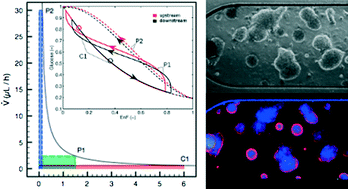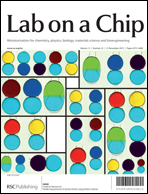Optimal periodic perfusion strategy for robust long-term microfluidic cell culture†
Abstract
Long-term cell culture in microfluidic devices is an essential prerequisite for “on a chip” biological and physiological based studies. We investigated how medium delivery, from continuous to periodic perfusion, affects long-term cell cultures in a microfluidic platform. Computational simulations suggested that different delivery strategies result in different temporal profiles of accumulation and washing out of endogenous (EnF) and exogenous (ExF) factors, respectively. Thus, cultures exposed to the same overall amount of medium with different temporal profiles were analysed in terms of homogeneity, cell morphology and phenotype. Murine and human cell lines (C2C12 and HFF) and mouse embryonic stem cells (mESC) were cultured in microfluidic channels. An ad hoc experimental setup was developed to perform continuous and periodic medium delivery into the chip, tuning the flow rate, the perfusion time, and the interval of perfusion while using the same amount of medium volume. Periodic medium delivery with a short perfusion pulse ensured cell homogeneity compared to standard cell culture. Conversely, a continuous flow resulted in cell heterogeneity, with abnormal morphology and vesiculation. Only dramatic and unfeasible increasing of perfused medium volume in the continuous configuration could rescue normal cell behaviour. Consistent results were obtained for C2C12 and HFF. In order to extend these results to highly sensitive cells, mESC were cultured for 6 days in the microfluidic channels. Our analysis demonstrates that a periodic medium delivery with fast pulses (with a frequency of 4 times per day) resulted in a homogeneous cell culture in terms of cell viability, colony morphology and maintenance of pluripotency markers. According to experimental observations, the computational model provided a rational description of the perfusion strategies and of how they deeply shape the cell microenvironment in microfluidic cell cultures. These results provide new insight to define optimal strategies for homogeneous and robust long-term cell culture in microfluidic systems, an essential prerequisite for lab on chip cell-based applications.


 Please wait while we load your content...
Please wait while we load your content...